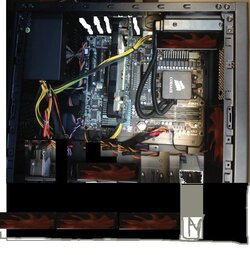- Joined
- Nov 19, 2012
- Location
- San Francisco, Ca
- Thread Starter
- #41
Welcome to Overclockers Forums! Join us to reply in threads, receive reduced ads, and to customize your site experience!
Actually I suggest a front to back airflow pattern instead of down to top.
His case looks good for this, it has mesh covers in the 5.25 bays...
Try this: Fit a 120mm fan in the 5.25" bays under or over your optical drive. You can pressure-mount it using some foam or whatever. That will lower cpu temps and cool your ram and NB.
Use front intake fans in the two lower intake spots as well, remove your pci slot covers and if you have any top exhaust fans put them in the front as intakes, and do a push pull setup with your radiator as exhaust.
